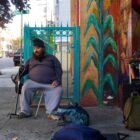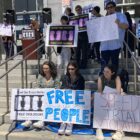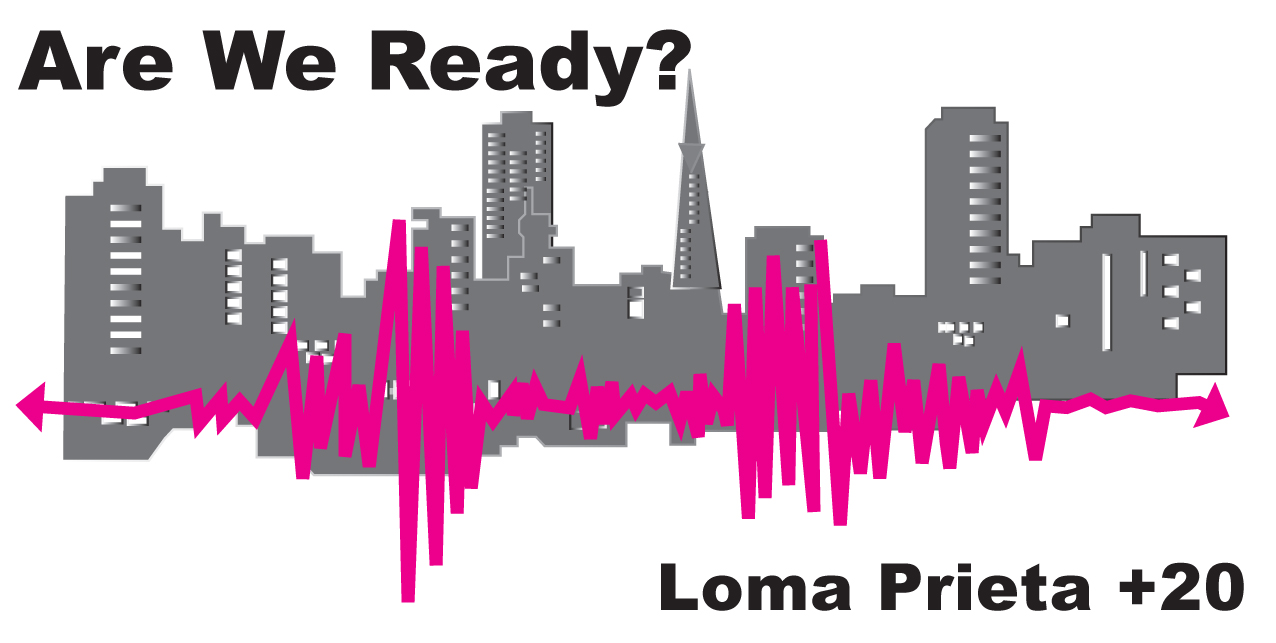
As San Francisco marks the 103rd anniversary of the 1906 earthquake Saturday, the city’s only free, hands-on emergency training program could be stalled by the budget cuts threatening every municipal agency.
The Neighborhood Emergency Response Team program — NERT — surpassed its annual goal of training 2,000 volunteers in four of the past five years and aims to increase participation by 25 percent this year. In addition to financial concerns, NERT’s biggest challenges are its dependence on word-of-mouth promotion and the language barriers that isolate people throughout the city. And yet, the program, which is run by the San Francisco Fire Department, is making strides in training volunteers and recruiting team leaders in underserved districts.
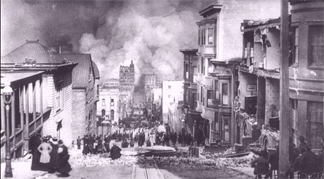 |
| Sacramento Street and approaching fire/Photo by This photograph by Arnold Genthe (from Steinbrugge Collection, UC Berkeley Earthquake Engineering Research Center) |
NERT has trained more than 18,500 people in personal preparedness and basic disaster response since 1990. It expects to train 2,500 volunteers between July 2008 and June 30, which marks the end of the department’s fiscal year, says Lt. Erica Arteseros, NERT’s program coordinator since March 2004.
“With the direction we’re heading, the program is really healthy,” Arteseros says. “New people keep getting trained, and the volunteers that take the training keep wanting to advance their knowledge and improve their skills so that they will be ready.”
The training is free to anyone who lives or works in the city. Basic NERT training includes lessons on preparedness and hazard mitigation, disaster skills, disaster medicine, light search and rescue and team organization and management. The 20 hours of training are presented in a six-class series. The program also offers advanced training and more intensive courses – which cover the full curriculum in four classes or two all-day sessions – as well as a one-session basic preparedness class offered in partnership with SF Safe, a neighborhood watch program.
There is no commitment to stay involved with NERT after graduation. At a minimum, participants learn what to do for themselves and their families to prepare for and in the event of a local disaster, and how much help they can expect from the city – which, the fire department warns, won’t be much in the immediate aftermath of a major quake.
“You can’t get everywhere with 305 people,” which is the number of firefighters staffed in San Francisco on a daily basis, Arteseros says. “We do have a recall program to bring additional staff into the city. But we can’t staff on a day-to-day basis for ‘the big one.’ So the training that we provide is really going to help people augment because there is going to be a gap in service.”
At the same time, the fire department cautions that untrained, on-the-spot volunteers are difficult to coordinate and more likely to rush into dangerous situations during a major disaster.
“If you know you’re the type of person that flings open your door and runs down the stairs and wants to help, please get training, so that you know exactly where to go,” Arteseros says.
The cost of being prepared
NERT has more than 10,000 graduates on its e-mail distribution list. But not all of those people are on neighborhood teams or plan to participate in rescue activities. Ultimately, the city does not have enough trained volunteers to respond after the next big earthquake.
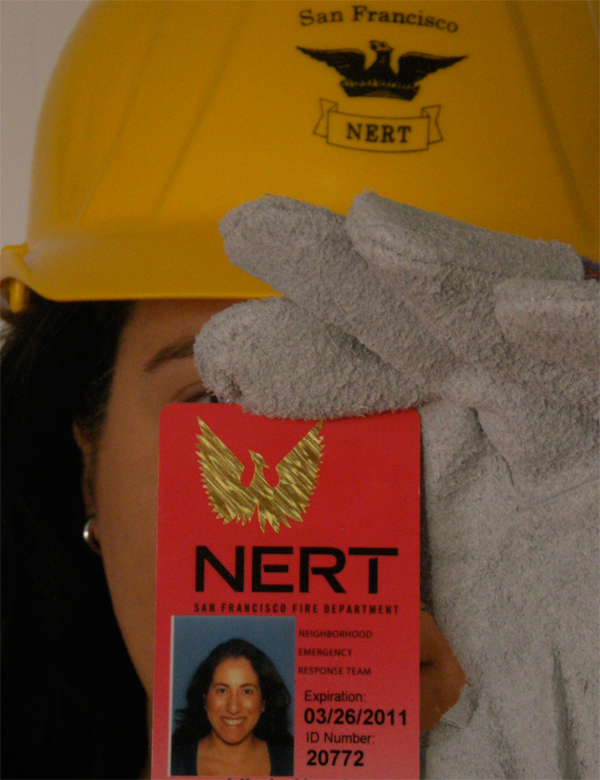 |
| Photo illustration by Public Press staff |
“I think a better target for us would be closer to 5,000 people trained during a budget cycle, just in terms of the turnover that we have in San Francisco, and people moving and coming and going,” Arteseros says. “If one person were trained per block, and from each block they sent someone to the staging area, that would be awesome.”
Although current budget and staff constraints won’t accommodate that level of growth, the existing program has the capacity to train more volunteers than it currently does. Participation has increased in recent years, but most NERT training classes are not filled. A typical class can accommodate 100 participants; enrollment ranges from 40 to 100 students per class.
The NERT program grew from community activism after the 1989 Loma Prieta earthquake.
“It’s actually like a citizen movement,” Arteseros says. Residents who were members of SF Safe and who lived in the Marina District, which was damaged severely in the 1989 earthquake, set the program in motion.
Early NERT volunteers paid $25 apiece for their own training. Later, general funding supported the program and classes were offered free of charge. After the Sept. 11, 2001, attacks, NERT received additional money through the U.S. Department of Homeland Security. That funding has since been cut and the program is once again generally funded.
As of August 2008, the fire department had budgeted $451,462 for NERT in fiscal 2009, about 5 percent more than the previous year. This year, Mayor Gavin Newsom has asked all city agencies to present proposals aiming for budget cuts of 25 percent.
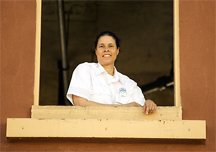 |
| Lt. Erica Arteseros, the SFFD NERT Training Program Coordinator, poses inside the SFFD Division of Training Facility on 2310 Folsom in the Mission the day before NERT’s City Wide Drill where she expects up to 350 volunteers to attend./Monica Jensen |
Arteseros says that she does not know whether or how those cuts might affect the NERT program, even though it is broadly supported.
“I don’t think anything in the fire department is protected,” she says. “But (NERT) is a very practical use of the taxpayer dollars. And it’s such a small amount compared to what you get in terms of hours of service from the volunteers.”
At the end of each NERT class series, instructors – who are all San Francisco firefighters – ask participants to contact their lawmakers to recommend continued program support. Participants at other programs around the country are required to pay for their own training and equipment, but Arteseros does not want San Francisco’s NERT to exclude people who can’t afford those fees.
Last year, the state authorized a one-time grant of $75,000 to the city’s NERT program to purchase supplies and for a series of workshops on personal preparedness.
Spreading the word
San Francisco supports several emergency preparedness programs. Most, like 72hours.org, focus on what individuals and families need to do to prepare for a disaster. NERT is the only free, hands-on training that teaches volunteers how to be self-sufficient and how to work in teams to help people outside of their households or workplaces. NERT is the only program that will have volunteers integrated with city’s disaster response through the fire department. The city’s emergency response – incorporating all city agencies – is coordinated through the Department of Emergency Management.
Integrating volunteers into that effort requires coordination. NERT will hold its annual citywide drill on Saturday (April 18) at Everett Middle School, 17th Street at Church. Arteseros expects between 300 and 400 NERT volunteers to participate. Other targeted drills throughout the year typically draw 10 to 40 participants.
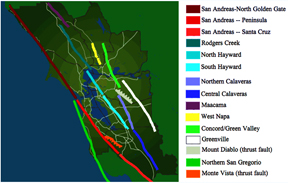 |
| Fault line map/ABAG illustration |
“In the basic 20-hour training, it’s hard to help people understand what’s really going to happen when it happens,” Arteseros says. “You sort of take bite-sized chunks, and you give people pieces of the skills you want them to have. And on drill day, we try to put that all together.”
NERT’s marketing is grassroots, with most effective recruiting via word of mouth, and primarily through volunteers.
“I’ll be brutally honest about it … I still meet people every single day that have never heard that the fire department has had this training program for 20 years,” Arteseros says.
The program also posts fliers on community boards in stores and coffee shops and tries to network through existing groups like SF Safe, parent teacher associations and city supervisor networks. NERT’s one-session classes, co-sponsored by SF Safe, on basic preparedness sometimes inspire participants to pursue the full training program.
The strength of a NERT team in a particular neighborhood is dependent on the volunteers who take on leadership roles in those groups. NERT currently has team leaders in 45 of 53 designated neighborhoods; groups with strong leadership tend to have better volunteer retention.
The Sunset District group is strong and holds regularly scheduled meetings, Arteseros says. Conversely, she has been concerned about Visitation Valley: “It is the end of our city, and we have had a really hard time getting enthusiasm there.”
‘Reach one, teach one’
Recently, Arteseros sent a letter to every NERT graduate in that neighborhood asking for volunteers to lead a neighborhood team. The effort paid off. Within one week, two people volunteered; they will receive extra training to help them recruit and organize volunteers in their neighborhood.
NERT aims to offer one training sequence in each neighborhood at least once a year. Four years ago, the Bayview District classes were sparsely attended. This month, the Bayview basic training class graduated about 60 volunteers, including about 25 who live in the neighborhood.
NERT has found challenges recruiting in the Richmond District, and not for the most obvious reasons.
“It’s not an underserved area and it’s not an economically challenged area,” Arteseros says. She suspects that language is a factor in the Richmond, which has a significant Cantonese-speaking population. NERT offer classes in Cantonese, but they are held in Chinatown. NERT does not yet offer classes in Spanish, but Arteseros hopes to initiate them soon.
Volunteers are ready to support that effort. Kevin Ward and Consuelo Garcia are co-coordinators of a NERT group in the Mission District. Their NERT staging area – where the group will meet in the event of a disaster – is Parque Ninos Unidos at Folsom and 23rd streets. Garcia says they aspire to lead a bilingual NERT group.
“If we get that (Spanish) class, we have plans for how to invite other people in the community,” says Garcia, who learned about NERT from a sign posted in her neighborhood.
The Mission group holds monthly meetings; about 15 people attend regularly. Ward and Garcia are in the process of contacting every NERT graduate in the neighborhood and try to vary the meeting schedule so that more people can be involved.
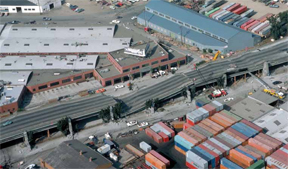 |
| Loma Prieta aftermath, Oakland/USGS photo |
Ward says that his involvement as NERT group leader came from a personal realization of the need to move “beyond the ideology of individualism, the idea that somehow we can just take care of ourselves to the exclusion of everyone else is, I think, going to be a fallacy when we see how much we need each other, when an earthquake like the one that hit in Italy hits here.”
Garcia says that she feels “more safe knowing that people are able to do something, than if we only depended on the fire department.
“Even if the fire department will have the time and enough people to come and assist us, it’s good that you know what to do,” she says. “I feel more safe knowing that there are programs like this.”To find out more about San Francisco’s NERT program, call (415) 970-2022 or go to sfgov.org/sfnert. There is a link from that page to other Bay Area preparedness and disaster training programs.

